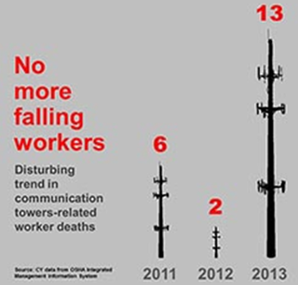 Kathy Pierce expected her son, Chad Weller, to come home on March 19, 2014, at the end of his shift as a cell tower climber. But Weller, always ready with a smile for his mother, never came back. He was sent up alone to fix a communication signal on top of a water tower in the rain while wearing a harness two sizes too big - and he lost his life in a fatal fall. Chad Weller is one of 11 workers who have lost their lives in 2014 while constructing or repairing cell towers. Thirteen died in the previous year, including Bridgette Hester's husband, who was killed as he worked on a tower that was struck by a vehicle and collapsed.
Kathy Pierce expected her son, Chad Weller, to come home on March 19, 2014, at the end of his shift as a cell tower climber. But Weller, always ready with a smile for his mother, never came back. He was sent up alone to fix a communication signal on top of a water tower in the rain while wearing a harness two sizes too big - and he lost his life in a fatal fall. Chad Weller is one of 11 workers who have lost their lives in 2014 while constructing or repairing cell towers. Thirteen died in the previous year, including Bridgette Hester's husband, who was killed as he worked on a tower that was struck by a vehicle and collapsed.
Kathy Pierce and Bridgette Hester joined the Department of Labor, the Federal Communications Commission and leaders in the telecommunications industry, including major carrier AT&T, at an unprecedented joint event today focused on new and continuing efforts to prevent worker fatalities on cell towers. U.S. Secretary of Labor Thomas E. Perez and FCC Chairman Thomas E. Wheeler spoke at the event to announce a new working group that will collaborate in the development and implementation of recommended safety practices for the growing telecommunications industry.
Small but dangerous
"The cellphones in our pockets can't come at the cost of a worker's life. The cell tower industry might be small, with 10,000 to 15,000 workers, but it's quickly proving to be one of the most dangerous. If we don't do something now, the number of fatalities is going to grow as fast as the industry does," said Secretary Perez. "We know we can't solve this problem alone though, and that's why I am so glad to be joined in partnership on this issue with the FCC and major carriers like AT&T. It's a perfect example of federal agencies and industry breaking down barriers and identifying common goals to save workers' lives."
Root causes, solutions
The event featured a morning workshop led by the Occupational Safety and Health Review Commission, comprised of two panel discussions featuring representatives from OSHA, the FCC, AT&T and the National Association of Tower Erectors. The first panel discussed the root causes of the high fatality and injury rates, while the second explored solutions. During the discussions, OSHA shared steps taken to curb these injuries and fatalities, including public outreach and enforcement, as well as the agency's emphasis on worker training.
Deaths are preventable
"The fatality rate in this industry is extraordinarily high - tower workers are more than 10 times as likely to be killed on the job as construction workers," said Assistant Secretary of Labor for Occupational Safety and Health Dr. David Michaels. "But these deaths are preventable. OSHA has developed a comprehensive initiative to ensure that safer working conditions and best practices are not just recommendations, but the law of the land. We look forward to the help FCC and industry can provide in making this a reality."
Following OSHA's workshop, members of the Telecommunications Industry Registered Apprenticeship Program, Assistant Secretary of Labor Dr. Michaels, Chairman Wheeler and Secretary Perez participated in a signing ceremony for the new apprenticeship program. It was spearheaded by the telecommunications industry, with the advice and assistance from the Department of Labor, and will provide high-quality skills and safety training for telecommunication tower technicians.
For more information on worker safety on the communication towers, please visit OSHA's Web page at https://www.osha.gov/doc/topics/communicationtower/.


